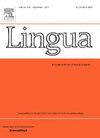An exploratory analysis of code-switching and borrowing in a corpus of Zimbabwean English
IF 1.3
3区 文学
0 LANGUAGE & LINGUISTICS
引用次数: 0
Abstract
This paper explores patterns of English-Shona code-switching and borrowing in a corpus of Zimbabwean English to determine the types, frequencies, and functions of these features. Results indicate that intrasentential code-switching was the most frequent type of switching followed by intersentential code-switching and then lexical borrowing. The least frequent type of switching was loanword adaptations. The analysis revealed that spoken registers had the highest frequency of switching compared to written registers. The informal and spontaneous nature of spoken registers were cited as motivations for the high frequency. Subsequently, multi-word switches occurring in the same place were attested more, which can be linked to their higher frequency of occurrence in public dialogues. Social functions, namely accommodation and solidarity, had the highest frequencies whilst switching at a time of vagueness or uncertainty was the second highest function of code-switching. Other functions of code-switching attested in the Zimbabwean English corpus, in the order of frequency, include repetition or reiteration, asking questions, identity marking, code-switching to show emotions, code-switching as discourse marking, clarification, and emphasis. Analyzing the functions of code-switching in the Zimbabwean English corpus and determining the frequency of each function is crucial for understanding the linguistic-, cognitive-, and sociocultural dimensions of bilingualism in Zimbabwe.
津巴布韦语英语语料库中语码转换和借用的探索性分析
本文探讨了津巴布韦语语料库中英修那语语码转换和借用的模式,以确定这些特征的类型、频率和功能。结果表明,句子内语码转换是最常见的语码转换类型,其次是句子间语码转换,其次是词汇借用。最不频繁的转换类型是外来词适应。分析显示,与书面记录相比,口头记录的转换频率最高。口语的非正式和自发性质被认为是高频的动机。随后,在同一地点发生的多词转换得到了更多的证实,这可能与它们在公共对话中的出现频率更高有关。社会功能,即适应和团结,频率最高,而在模糊或不确定的时候切换是第二高的功能代码转换。在津巴布韦语英语语料库中,语码转换还具有重复或重申、提问、身份标记、表达情感的语码转换、作为话语标记的语码转换、澄清和强调等功能。分析津巴布韦语英语语料库中语码转换的功能,确定每种功能的频率,对于理解津巴布韦双语的语言、认知和社会文化维度至关重要。
本文章由计算机程序翻译,如有差异,请以英文原文为准。
求助全文
约1分钟内获得全文
求助全文
来源期刊

Lingua
Multiple-
CiteScore
2.50
自引率
9.10%
发文量
93
审稿时长
24 weeks
期刊介绍:
Lingua publishes papers of any length, if justified, as well as review articles surveying developments in the various fields of linguistics, and occasional discussions. A considerable number of pages in each issue are devoted to critical book reviews. Lingua also publishes Lingua Franca articles consisting of provocative exchanges expressing strong opinions on central topics in linguistics; The Decade In articles which are educational articles offering the nonspecialist linguist an overview of a given area of study; and Taking up the Gauntlet special issues composed of a set number of papers examining one set of data and exploring whose theory offers the most insight with a minimal set of assumptions and a maximum of arguments.
 求助内容:
求助内容: 应助结果提醒方式:
应助结果提醒方式:


